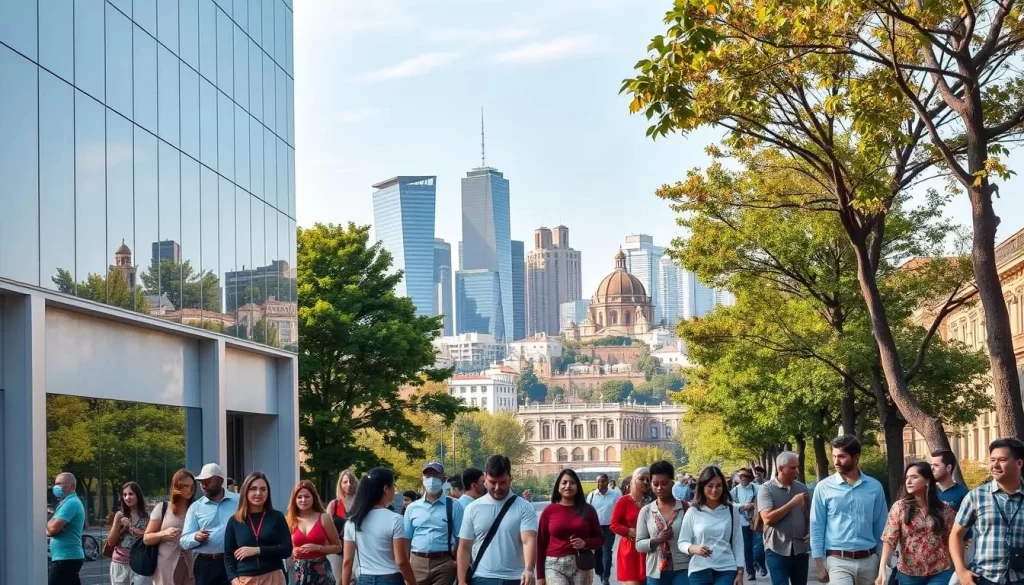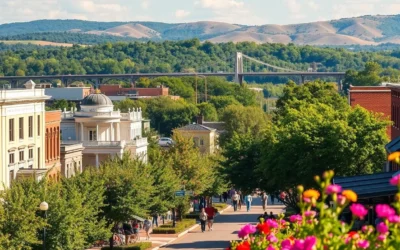✓ Accommodations ✓ Flights ✓ Rental Cars
As you explore the linguistic landscape of South Carolina, you’ll uncover a rich tapestry of languages spoken across the state. With approximately 1.96 million households, the population is diverse, and so are the languages spoken at home.
While English is the predominant language, around 7.4% of residents over four years old speak a non-English language at home, totaling about 367,000 residents. This diversity is a result of historical immigration patterns that have shaped the state’s linguistic makeup.
As you delve into this article, you’ll gain insights into the limited English proficiency population and the services available to them. You’ll also discover the various languages spoken in South Carolina, making this a valuable resource for researchers, educators, and business owners alike.
The Linguistic Landscape of South Carolina
South Carolina’s residents speak a variety of languages, reflecting the state’s rich cultural heritage. As you delve into the linguistic landscape, you’ll find that the state’s language diversity is an essential aspect of its identity.
English as the De Facto Official Language
English is the predominant language in South Carolina, serving as the de facto official language for government, education, and daily life. Most residents communicate effectively in English, but there’s a notable segment of the population that speaks other languages at home.

Language Diversity Statistics
An estimated 7.4 percent of South Carolina residents over the age of four speak a non-English language at home, which translates to around 367,000 residents based on average household sizes. You should note that approximately 2.93 percent of the state’s population has limited English proficiency (LEP), facing challenges in communicating effectively in English.
Some key statistics highlighting language diversity in South Carolina include:
- Language diversity varies significantly across different regions, with urban areas showing greater linguistic diversity than rural communities.
- The state’s multilingual population, although less diverse than states like California or New York, still maintains a notable presence.
- These language statistics have important implications for service providers, healthcare facilities, government agencies, and businesses operating in the state.
Understanding these demographics helps you recognize the need for translation and interpretation services in various contexts throughout South Carolina. By acknowledging and addressing the linguistic needs of its residents, the state can better serve its diverse population.
Immigration History and Its Impact on Languages in South Carolina
As you explore the linguistic diversity of South Carolina, you’ll discover that the state’s immigration history plays a significant role in shaping its language landscape. The population of South Carolina has been shaped by various immigration waves, resulting in a diverse range of languages being spoken in the state.
Early European Settlement and Indigenous Languages
When European settlers first arrived in South Carolina, they encountered indigenous communities with their own languages. The early European settlement had a lasting impact on the language and culture of the region. As a result, the state’s linguistic landscape was initially shaped by the interactions between European settlers and Native American communities.
19th and 20th Century Immigration Waves
During the 19th and 20th centuries, South Carolina experienced significant immigration waves from various parts of the world. As a result, the state’s communities became more diverse, with people bringing new languages and cultures. The Hispanic population grew substantially, making Spanish a prominent language in the state.

Modern Immigration Patterns
Today, South Carolina continues to experience immigration from various countries, with the Hispanic population continuing to grow. You will also notice increased immigration from Asian countries, introducing new languages like Vietnamese, Chinese, and Korean to the state’s linguistic landscape. As a result, businesses and government agencies have had to adapt by offering translation services and multilingual resources to ensure effective communication and access for all.
South Carolina, United States: Official and widely spoken languages
Understanding the languages spoken in South Carolina is crucial for residents, visitors, and businesses operating in the state. The linguistic diversity reflects the state’s cultural heritage and the various languages its residents speak.
Limited English Proficiency (LEP) Population
Approximately 2.93% of South Carolina’s population is considered to have Limited English Proficiency (LEP). This segment of the population relies heavily on languages other than English. An estimated 7.4% of residents over the age of four speak a non-English language at home. This indicates a significant need for language services to support these communities.

Language Distribution Across the State
The distribution of languages across South Carolina varies, reflecting the state’s demographic makeup. While English is the predominant language, other languages are widely spoken due to the state’s diverse population. The language distribution is influenced by factors such as immigration patterns and the presence of international businesses.
Language Use in Different Contexts
Language use in South Carolina varies significantly across different contexts. Many bilingual residents speak their native language at home while using English in public, educational, and professional settings. In healthcare settings, facilities often employ interpretation services to ensure effective communication. Additionally, religious institutions serve as centers for language maintenance, conducting services in languages like Spanish, Korean, or Vietnamese.
The workplace language patterns differ by industry, with sectors like construction and agriculture having significant numbers of workers who primarily communicate in languages other than English. In educational contexts, English dominates classroom instruction, but schools increasingly offer support for English language learners and sometimes bilingual education programs.
Top 10 Non-English Languages in South Carolina
As you explore the linguistic diversity of South Carolina, you’ll discover the top 10 non-English languages that are widely spoken. The state’s cultural landscape is shaped by the various languages spoken by its residents. This section will delve into the details of these languages, providing insights into the communities that speak them.
Spanish
Spanish is the most widely spoken non-English language in South Carolina, reflecting the significant Hispanic population in the state. With many Spanish speakers integrated into various aspects of life, from business to education, the language plays a vital role in the state’s cultural fabric.
German
German is another prominent language in South Carolina, with a notable number of speakers. The language is often associated with cultural events and heritage, maintaining its presence in the state through community activities and language localization efforts.
Chinese (Mandarin and Cantonese)
The Chinese community in South Carolina contributes to the state’s linguistic diversity, with both Mandarin and Cantonese being spoken. As the community continues to grow, the language remains an essential part of their cultural identity, with many speakers involved in business and education.

French
French is spoken by a sizable community in South Carolina, with many speakers maintaining their cultural heritage through language and cultural events. The presence of French is evident in various aspects of life, from education to cultural festivals.
Tagalog
Tagalog, the language from the Philippines, has a significant number of speakers in South Carolina. The community is active in various sectors, with many speakers contributing to the state’s economy and cultural diversity at the min level of community engagement.
Vietnamese
The Vietnamese community in South Carolina is vibrant, with the language playing a crucial role in their daily lives. Many Vietnamese speakers are involved in business, healthcare, and education, contributing to the state’s diverse cultural landscape over time.
Russian
Russian is spoken by a notable community in South Carolina, with many speakers maintaining their cultural heritage. The language is used in various contexts, including cultural events and community gatherings.
Portuguese
The Portuguese language is represented in South Carolina, with a community that actively maintains its cultural identity. Many Portuguese speakers are involved in business and cultural activities, contributing to the state’s linguistic diversity.
Hindi
Hindi, a prominent language from India, is spoken by a sizable community in South Carolina. The language is an integral part of their cultural identity, with many speakers involved in business and education.
Gujarati
Gujarati rounds out the top 10 non-English languages in South Carolina, with approximately 4,812 speakers representing about 0.10% of the state’s population. The Gujarati-speaking community primarily consists of immigrants from the Gujarat state in western India and their families. Many Gujarati speakers are involved in business ownership, particularly in the hospitality industry, convenience stores, and small retail businesses. Gujarati cultural associations and religious centers, particularly Hindu temples, serve as important gathering places where the language is actively used and maintained.
Language Access and Services in South Carolina
As the linguistic diversity in South Carolina continues to grow, the need for language access and services becomes increasingly important. This diversity is reflected in the various languages spoken across the state, making it essential to have professional translation and interpretation services available.
Legal Requirements for Language Access
South Carolina must comply with federal regulations regarding language access. This includes providing interpretation and translation services in healthcare, legal, and government sectors to ensure equal access to information and services for individuals with limited English proficiency.
Translation and Interpretation Services
The demand for translation and interpretation services in South Carolina is met by a range of providers, from national companies to local specialists. These services include on-site interpretation, over-the-phone interpretation, video remote interpretation, and document translation, catering to various industries such as healthcare and legal. Businesses and organizations can access certified document translations and specialized interpretation services, ensuring effective communication with diverse populations.
Conclusion
As we’ve explored the linguistic landscape of South Carolina, it’s clear that the state’s language diversity is a significant aspect of its cultural identity. The data shows that while English remains dominant, South Carolina hosts a diverse array of other languages reflecting its immigration history and changing demographics. This linguistic diversity creates both challenges and opportunities for businesses, healthcare providers, and government agencies. Understanding the legal requirements for language access and the growing industry of translation and interpretation services is crucial. As South Carolina continues to evolve demographically, its linguistic landscape will further diversify, making language access services increasingly important today.
The above is subject to change.
Check back often to TRAVEL.COM for the latest travel tips and deals.






